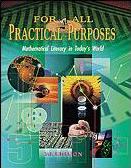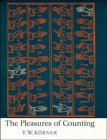book review
In this book, Martin Gardner, best known for his columns on recreational maths in Scientific American and the many books collecting this material, surveys a wide range of mathematical magic. Many of the tricks described require little or no dexterity and nothing except readily available props, such as cards or dice, and so are suitable for the beginner.
"The Language of Mathematics" is a book that sets itself an ambitious task - to sum up all of mathematics. Clearly, the author does not intend to do this without omissions - mathematics is far too large a subject for that - rather, he hopes that the reader will come away with an understanding of what maths is and what mathematicians do and why.
John Haigh takes the above quote as the epigraph for "Taking Chances", and makes his own significant contribution to scientific literacy. He concerns himself with "games of chance" in the broadest sense, from the National Lottery, quiz shows, casino games and card, dice and coin games, through game-theoretic "games" such as military conflicts, to all types of sports.
This is one of the world's outstanding pedagogic texts. It has the rare distinction of being a mathematics book that has sold a million copies. The COMAP project is a coalition of leading mathematicians and educators, directed by Solomon Garfunkel, who over a period of twelve years and five ever-expanding editions have created a beautiful introduction to the practical applications of some of the most important areas of discrete mathematics.
"The pleasure and interest of being a scientist need not be confined to those gifted people who have the ability to pursue the highly specialised studies which are necessary for those who would reach the main frontiers of scientific advance."
G. I. Taylor, one of the great physicists of the twentieth century, among the last masters of both theory and experiment.
Computers can do many things, but there are some things they can't do. They certainly can't play tennis or the violin, but those aren't the kinds of thing we're concerned with. There are computational questions, questions of the kind that we would naturally turn to a computer to help us with, that, in fact, they cannot answer (and nor, therefore, can we).
Robin J Wilson's book is "not", as he assures the reader in the Preface, "a history of mathematics book in the conventional sense of the word". No indeed. It is, rather, a selective account of aspects of the history of mathematics which have appeared on postage stamps from across the world.
Money is peculiar stuff. It has no use of any kind apart from its value in exchange for something else, and this grows over time as it earns interest, or shrinks as inflation overtakes it. If you have money to invest, there are a bewildering array of different kinds of financial instrument available: interest-bearing accounts, bonds, pension funds, stocks and shares, options ...
Avid readers of popular books on the laws of nature are tolerably familiar with a number of facts. They know that electricity, magnetism and the weak force between elementary particles have been unified, that Einstein's theory of special relativity arose from an attempt to reconcile Newtonian mechanics with the laws of electromagmetism, and that his later theory of general relativity had something to do with the structure of spacetime.
The very fetching purple and yellow packaging states that this is "the" interactive geometry software. A little optimistic, perhaps; The Geometer's Sketchpad and Cabri both have their - not insubstantial - followings. And the previous release of Cinderella gave the impression of a terribly well-featured package lacking slickness. But therein lies the value of Version 1.2: slickness.
The author says in the introduction that "this book is intended as a polemic", and a polemic it certainly is. Whether or not you like the book will therefore depend not only on whether you agree with his thesis, but also on whether or not you like polemic.
The golden section (or golden ratio), famously, was used in antiquity, when the ancient Greeks built temples the proportions of whose parts - by accident or design - are often supposed to have fallen in the golden ratio.











